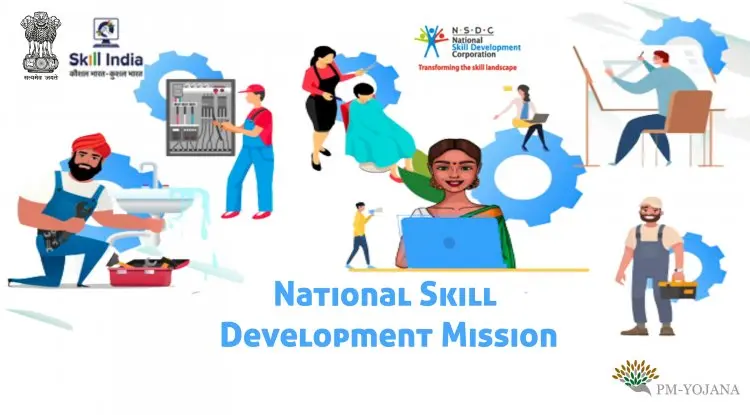National Skill Development Mission
It aims to create opportunities for the development of talent within the country and improve the overall scope and space for underdeveloped sectors.

National Skill Development Mission
It aims to create opportunities for the development of talent within the country and improve the overall scope and space for underdeveloped sectors.
SKILL INDIA
Introduction
In 2015, Prime Minister, Mr. Narendra Modi launched the Skill India Mission, which was in accordance with his vision to help India become ‘Atmanirbhar’ (self-reliant). This initiative was aimed to create and implement comprehensive skill development training programmes that would help bridge the gap between industry demands and skill requirements and therefore, develop the country at large.
The skill India programmes comprised implementing curriculum-based skill training courses, wherein trainees would gain certifications and endorsements from industry-recognised learning centres. The mission also involved incorporating skill-based learning in school curriculum, creating opportunities for both long- and short-term skill training and employment.
Need for Skill India Initiative
With India being a ‘young’ country due to its 75% working-age population, development of a skilled and educated workforce will play a significant role in enhancing its overall economy.
According to the International Labour Organisation (ILO), India is likely to face shortage of ~29 million skilled personnel by 2030. Following this, Accenture in 2019 predicted that if India does not take timely actions—such as invest in new technologies or build industry-required skills—the skill deficit could cost the country US$ 1.97 trillion in terms of gross domestic product (GDP) over the next decade.
With ‘Skill India Mission’, the Indian government aims to develop those practical skills, which are required by the industry and therefore, improve employment rate in the country.
Since implementation, the mission has helped boost employment. According to data from the Centre for Monitoring Indian Economy (CMIE), unemployment rate dropped to 6.5% in January 2021 from 9.1% in December 2020, while the employment rate increased to 37.9% in January 2021 from 36.9% in December 2020.
Skill India Mission
Through this initiative, the government aimed to train >40 crore (400 million) people in India in various skills by 2022.
Key skills:
- Apprenticeship training – The programme was launched to enhance apprenticeship opportunities in the country by providing post-education job training to graduates/diploma holders in engineering.
- Technical intern training programme (TITP) – This programme encourages international cooperation by facilitating transfer of skills, technology and expertise among the participating countries and thereby, assists in developing human resources. The program provides opportunities to students for professional development courses in Japan's industrial society for a set period (3-5 years).
- Online skilling – The ‘e-Skill’ India portal links B2C e-learning sites that operate digitally and build & source e-learning content.
Key departments
Under the Skill India Mission, the government established key departments to govern and support various skill development programmes.
Key schemes
In addition, the government has introduced numerous key schemes to ensure that the ‘Skill India Mission’ programmes is implemented throughout the county.
Pradhan Mantri Kaushal Vikas Yojana (PMKVY)-
- Under the Skill India Mission, the Ministry of Skill Development and Entrepreneurship (MSDE) is implementing the Pradhan Mantri Kaushal Vikas Yojana (PMKVY), Jan Shikshan Sansthan (JSS) for skill-based learning and the National Apprenticeship Promotion Scheme (NAPS) across the country.
- Under PMKVY 2.0 (2016-20), funds worth ~Rs. 7,279 crore (US$ 977.40 million) have been issued to implementing agencies as of February 2021.
- The target was to train 1 crore youth, under PMKVY 2.0 (2016-20). As of January 2021, 1.07 million candidates have been trained.
- Under PMKVY 3.0, which was launched on January 15, 2021, the government introduced demand-driven, short-term development training programmes for all districts in the country.
Jan Shikshan Sansthan (JSS)-
- The scheme provides vocational training to the underprivileged population (scheduled castes/scheduled tribes/minorities), with minimum infrastructure and resources.
- Through various JSS skill programmes, 6.68 lakh candidates have been trained between FY19 and FY21 (until February 23, 2021).
Integration with General Education-
- The Ministry of Education (MoE) and the MSDE, among other administrative ministries, are planning a phased incorporation of vocational education programmes into mainstream education. In line with this, over the next five years, the National Education Policy (NEP) 2020 aims to empower 50% general education students to VET.
Pradhan Mantri YUVA (PM YUVA) Yojana-
- This scheme aims to create an enabling environment through entrepreneurship education and training and provide easy access to the entrepreneur network. It is applicable to 10 states (including Uttar Pradesh, Uttarakhand, Bihar, West Bengal, Tamil Nadu, Telangana, Kerala, Assam, Meghalaya and Maharashtra) and two union territories (Delhi and Puducherry).
SANKALP (Skills Acquisition and Knowledge Awareness for Livelihood Promotion)-
- Launched in January 2018, SANKALP is a World Bank-funded programme managed under Ministry of Skill Development. The total cost of the project stands at US$ 675 million, including US$ 500 million assistance from the World Bank that will be implemented in two tranches (US$250 million each) over six years until March 2023.
Skill India Mission – Recent Developments
- In April 2021, the government conducted a regional workshop in Gangtok, Sikkim, including all Northeast states—Arunachal Pradesh, Assam, Manipur, Meghalaya, Mizoram, Nagaland and Tripura—to empower State Skill Development Missions (SSDMS) and District Skill Committees (DSCs) and successfully implement the Pradhan Mantri Kaushal Vikas Yojana.
- In February 2021, the Technology Information, Forecasting and Assessment Council (TIFAC) launched SAKSHAM (Shramik Shakti Manch), a work portal for mapping skills of ‘Shramiks’ (labour) vis-à-vis the demand from MSMEs for better alignment and placement of 10 lakh blue-collared positions.
- In January 2021, the Union Cabinet approved a memorandum of understanding (MoU) between India and Japan on the basic framework for a partnership for proper operation of the system involving ‘Specified Skilled Worker’ (SSW).
- This MoU will provide an institutional framework for both countries to encourage movement of skilled workforce from India to Japan, who have the requisite abilities (including proficiency in the Japanese language) to work in 14 distinct sectors in Japan.
Skill India Mission – Budget allocation
In the Union Budget 2021-22, the government allocated funds worth Rs. 2,785.23 crore (US$ 379.06 million) to the Ministry of Skill Development and Entrepreneurship.
Conclusion
With India being termed as ‘a youth country’, its people can be its greatest strength. The country should not only train and develop its young workforce for the domestic economy, but also for the world; this can be achieved by mapping skills and developing corresponding training programmes, adopting best practises, embracing foreign campuses and achieving industry-ready skills.
In addition, the government's collaboration with global industries and individual participants will pave the way to effectively implement numerous initiatives and therefore, ensure availability of professional workforce and further increase employment; this could help India become the global skill capital.







